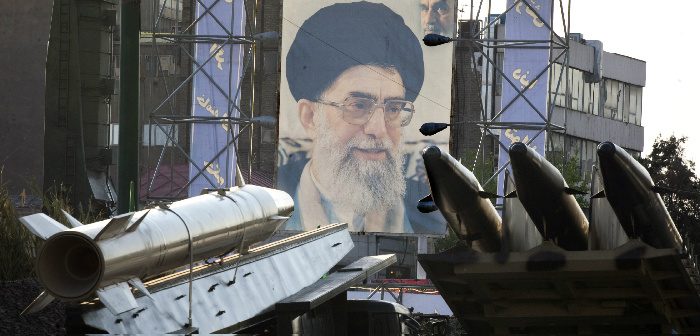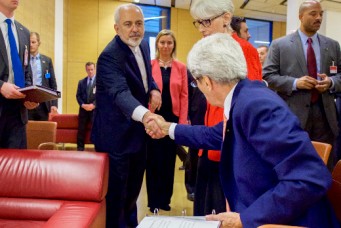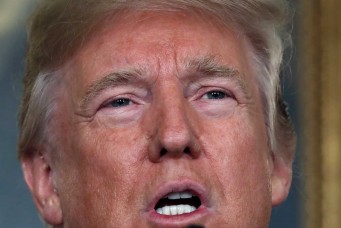Trump’s Short-Sighted Iran Strategy
President Trump’s aggressive stance against the Iranian Revolutionary Guards could further jeopardize regional stability and the Iran nuclear deal.

Iranian-made missiles on display at an exhibition organized by Iran’s revolutionary guards, Tehran, Sept. 23, 2011. Morteza Nikoubazl/Reuters
In his October 13 speech on the overall U.S. strategy toward the Islamic Republic of Iran, President Donald Trump declared two chief policy lines vis-à-vis the Iranian nuclear accord—formally known as the Joint Comprehensive Plan of Action (JCPOA)—and the Islamic Revolutionary Guards Corps (IRGC). On the one hand, he declined to certify Iran’s compliance with the JCPOA, kicking the ball to the court of U.S. Congress, and on the other he authorized further “tough sanctions” against the “entire” Revolutionary Guards.
This is a highly risky strategy that not only threatens to derail the Iran nuclear agreement once and for all, but can also imperil long-term American as well as European interests in the Middle East and beyond. While decertification of Iran’s nuclear observance and the possible scenarios it can entail have received adequate analytical attention in policy circles, it is not equally clear how the Iranian Revolutionary Guards might respond to unprecedented “counterterrorism” sanctions and what implications they may have for the nuclear deal itself.
In the Iran strategy speech, President Trump stopped short of ordering the U.S. State Department to incorporate IRGC in its most notorious and consequential blacklist of “Foreign Terrorist Organizations” (FTOs). That would entail sweeping penalties against the whole group and render it a global military target on a par with Al Qaeda and the Islamic State (IS). In all likelihood, it would also prompt Washington’s European allies to follow suit.
Yet, when Trump authorized the Treasury Department to sanction the “entire” IRGC, he was in fact following up on a Congress act signed into law on August 2, 2017. Technically speaking, according to “Countering America’s Adversaries Through Sanctions Act” (CAATSA) and more specifically based on its invocation of the Executive Order 13224—which was originally issued by former U.S. President George W. Bush in the wake of the September 11, 2001 attacks—the Treasury Department’s Office of Foreign Assets Control (OFAC) identified the Iranian Revolutionary Guards as a “Specially Designated Global Terrorist” (SDGT) and thus included it under the category “Specially Designated Nationals” (SDNs) on October 13. This can make the IRGC subject to secondary sanctions.
Put more simply, the new authorization regards IRGC as responsible for “Iran’s international program of destabilizing activities, support for acts of international terrorism, and ballistic missile program” and consequently levies comprehensive sanctions on the group as well as on the “foreign persons that are officials, agents, or affiliates” of it.
A few days before Trump outlined Washington’s new Iran strategy, the IRGC chief commander Mohammad Ali Jafari had warned that Tehran would consider the U.S. implementation of CAATSA “tantamount to unilateral withdrawal” from the nuclear deal, suggesting that Iran might respond in kind and scrap the agreement too. Jafari stressed that in response to the American designation of IRGC as a terrorist group, the Revolutionary Guards would similarly deem U.S. soldiers “all over the world, particularly in the Middle East” on a par with IS terrorists and treat them as such.
These and similar warnings by senior IRGC commanders notwithstanding, the Islamic Republic will likely continue to abide by the nuclear accord as long as the U.S. sticks to it and avoids reimposing nuclear-related sanctions. Speaking five days after Trump’s announcement of new Iran policy, Iranian Supreme Leader Ayatollah Ali Khamenei emphasized in a public address to students in Tehran that “if the other side does tear up the JCPOA, we will not tear it up either, but if they do, we will then shred it”.
In other words, Iran has basically adopted a “wait and see” approach to the nuclear pact and its ultimate decision will depend to a great extent on how the U.S. Congress decides, within the next sixty days, to treat it. However, given the institutionalized hostility and growing escalation of tensions between the Islamic Republic and the United States under Trump, it is unlikely that Tehran will passively wait and watch developments in Washington in the hope of a favorable outcome. The Revolutionary Guards in particular has a number of options short of discarding the JCPOA that it might utilize to retaliate against further U.S. punitive measures.
While the IRGC is unlikely to directly engage American military bases in the wider region—from the Fifth Fleet in Bahrain to the Al Udeid Air Base in Qatar to the Bagram Air Base in Afghanistan—as some of its commanders have implied, it can resort to confrontational behavior against U.S. vessels in waters surrounding Iran including the Persian Gulf and the Strait of Hormuz. In the most outstanding instance, IRGC naval forces arrested ten American crew members from two Navy boats that had blundered into Iranian territory in January 2016. The images of U.S. soldiers kneeling down with hands on their heads were particularly embarrassing to Washington at the time.
The Revolutionary Guards can also unleash its proxy networks against American forces in the Middle East and thus exploit U.S. vulnerabilities in Iraq and Afghanistan. Groups such as the Badr Organization, Kata’ib Hezbollah and Asaib Ahl Al-Haq, which are part of Iraq’s predominantly Shia Popular Mobilization Units (PMU) and heavily funded and influenced by Iran, can again jeopardize American lives and interests in the conflict-ridden country as they did in the years following the 2003 invasion of Iraq. Tehran can similarly raise the cost of war for the United States in Afghanistan by boosting its military and intelligence support for the Taliban. A similar scenario can be enacted in the Syrian conflict theater as well, where American engagement has grown under the Trump administration and U.S.-backed forces are closely fighting Islamic State militants in northeastern and eastern parts of the country.
Last but not least, Iran can start to double down on its missile program, for example by increasing the range of its ballistic missiles beyond the current 2000 km limit, which can already can reach Israel, while continuing to implement the nuclear accord. Such a retaliatory measure is bound to further test the balance of power in the Middle East and even affect European geopolitics beyond it.
Greater U.S. pressure on the Iranian Revolutionary Guards will far from check or contain it. On the contrary, it will reduce the organization’s motivation to restrain itself and can thus induce it to act even more aggressively outside of Iran. Pertinently, more external pressure will also enable the IRGC to play victim in the sphere of Iran’s domestic politics—as it has before—and get away with its malpractices including various forms of human right violation. Trump’s hawkish Iran strategy promises to empower Iranian hardliners rather than weaken them.
Maysam Behravesh is a doctoral candidate in the Department of Political Science and a Research Fellow in the Center for Middle Eastern Studies (CMES), Lund University.
Subscribe to Our Newsletter





